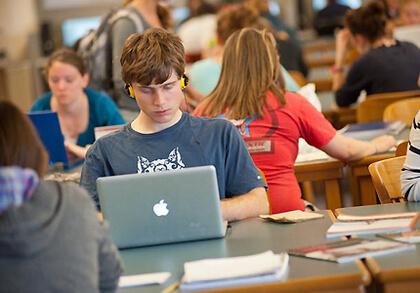The most thankless job on the UVM campus this week may belong to Angus Robertson, access supervisor at the Bailey/Howe Library.
Once an hour Robertson, who oversees Bailey/Howe’s circulation desk, traverses the upper two floors of the library, making sure equipment is in order, chairs and desks are in their proper places, and -- above all -- students are quiet.
With daily visits to Bailey/Howe topping 8,000 this time of year -- a huge increase over recent years and on par with the 26-story main library at UMass Amherst, which has double UVM’s undergraduate enrollment -- Robertson has his hands full.
Clustered around large square tables, holed up in vast warrens of cubicles, tucked into isolated nooks, packed into chairs between stacks, students on the upper floors resemble some stupendous bat colony in a favorite cave. Most are studying quietly, but their sheer numbers mean infractions occur, often by students enthusiastically discussing a group project, which Robertson handles with good cheer and practiced aplomb.
Bailey/Howe’s popularity is eloquent testimony that UVM is a more academic place today than it was; 10 years ago the library’s third floor was a ghost town, Robertson says. It’s also a product of robust undergraduate enrollment growth and happy campus planning that situated the Davis Center next door to the library, delivering droves of students to its doorstep.
Flaws
But its growing appeal is also exposing flaws in a facility that was designed in an earlier era for a much smaller student body.
The amalgamated Bailey/Howe facility -- Bailey was built in 1962, Howe added in 1980 -- was designed at a time when there were “30 percent fewer full-time students on campus,” says Peter Blackmer, the Libraries’ assistant dean for administrative services. “Infrastructure from seating to electricity was not intended to support this number of students.”
To address the needs of a larger, more academically inclined student body with 21st century information technology needs, UVM Libraries recently issued a request for proposals to imagine how the future might look. The Libraries are seeking a master plan to make better use of existing space in Bailey/Howe in the short term and develop strategies for how a troika of future facilities -- including a renovated Billings Library, where Special Collections will move, a proposed new Learning Commons, full of classrooms and technology-rich, multi-functioning space that will accommodate student group work, and a less stressed Bailey/Howe -- will function together.
Twenty-six firms responded. Administrators hope to choose one of them by mid- to late summer and to dig into the planning process -- which will involve extensive surveys with library users -- immediately after. No budget has been set for the changes the plan would propose, which the library’s leadership hopes will unfold over the next one to two years at Bailey/Howe and three to five years for the larger, multi-facility vision.
What you ask for
If UVM students are giving Bailey/Howe an excess of love today, that’s partly the fault of administrators, who effectively met student concerns that surfaced in 2005 when the library instituted LibQUAL, a once-every-four-years survey of its patrons.
Most of the student complaints related to the facility itself, and changes were largely aesthetic. New lighting, flooring, cushy chairs, and crisp, coherent signage were all added. The library also upgraded its wireless network, added a 24-hour Cyber Café and put new emphasis on outreach.
Not to be outdone, the reference desk won new followers by encouraging students to communicate with librarians digitally, via email, chat, and IM, as well as in person.
The impact of all the extra bodies the spiffed up facility was attracting was palpable, though, and showed up in responses to the 2009 edition of LibQUAL. Students, especially graduate students, were increasingly peeved at how loud the upper library floors were, which were billed as quiet zones.
In response, a new noise policy was put in place clearly delineating expectations on the three floors -- talking permitted on the first, whispering only on the second and third -- giving Robertson and his student employees clear behavioral guidelines to enforce when they make their rounds.
Outlets for frustration
No survey data was needed to identify another problem associated with overcrowding: a shortage of electrical outlets. While the library houses 240 desktop computers and recently added 220 new outlets, students toting laptops and other digital devices still arrive at the library in such great number -- the library’s wireless network regularly peaks at between 500 and 600 users -- students are forced to use outlets in hallways and camp out on the floor.
To address the problem, this year’s graduating seniors -- eschewing the traditional senior class gift of sculpted granite or glass -- have raised more than $5,000 to help fund a planned $17,000 installation of 140 to 160 new outlets.
Even with the packed bodies, many UVM students seem to love the library as it is and spend hours there. To accommodate students who want to make it their second home, 300 lockers were installed this year, so students can stash books and other study materials, go to class and return.
On the first floor, where talking is permitted, students do group projects at long tables, study in solitary cubes or work with a partner.
“With everyone studying here, it helps me focus a lot more,” says Staci Dellorco, a senior elementary education major from Franklin, Mass., who says she enjoys the library’s “atmosphere.”
“As a librarian, it’s great,” says Blackmer, of the cascading growth in library use. “The challenge is keeping up. In the past, we’ve made improvements, but at the margins. Rarely do we have a chance to step back and think of this facility and the ones we’re planning as a whole.”
The master planning process to come is an opportunity Blackmer and his colleagues clearly relish, whose fruits could fundamentally change the way students learn and live at the university.
